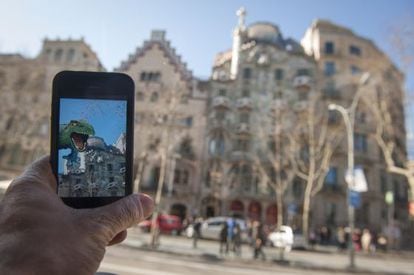Eight trends to follow at Barcelona’s Mobile World Congress
Bigger, cheaper phones, more apps and wearables will dominate this year’s showcase of the future in mobile telephony

Don’t say smartphone, just say cellphone. With one billion intelligent phones sold last year (53 percent of the total, and forecasted to rise to 70 percent this year), pretty soon there will only be one type of phone in the world. The latest edition of the GSMA Mobile World Congress (MWC) kicks off in Barcelona on Monday, set against a global scenario of optimism and booming sales.
The event began life in 1987 as an operators’ trade fair, and was later largely taken over by phone manufacturers, but for the last few editions it has been a showcase for what is really driving the cellphone market: applications. The stars of this year’s event will be Facebook supremo Mark Zuckerberg and Jan Koum of WhatsApp.
Like any other fashion show, much of what will be on display at MWC 2014 will seem over the top, but needs to be seen as confirming next year’s trends, or even those of the following year. This is a sector where the future is science fiction.
Six-inch screens. China’s ZTE will be unveiling its Grand Memo II LTE, with a six-inch screen, joining those already produced by Huawei, LG, and Sony, among others. Not to be left out, Samsung has already announced that the Galaxy 5S will be slightly bigger than its 5.2-inch predecessor. This is important, because we are not talking about some specialist device here, but a model aimed at the mass market. Screens are getting bigger, and there is no avoiding them, proof being that even the mighty Apple is being forced to join the trend: before the year is out, it will be launching a 5-inch-plus iPhone.
Lower prices. There will always be somebody prepared to pay a thousand euros for a bag when they could acquire one for 30. It’s the same with cellphones. Leaving aside the ever-smaller luxury end of the market, the trend is for prices to keep falling and quality to keep improving. There is no need any longer to spend 800 euros for a top-end cellphone. Chinese manufacturers are now producing them for around 100 euros. However much we’ve grown used to brand names, at the end of the day a low price is hard to beat. For example, the sale of no-name Chinese-made cellphones on Amazon.com has almost doubled in the last year. Which means that not even Huawei, which has models costing around 600 euros, can rest easy. The names to watch out for now are Bogo, Hisense, Jiayu, Lenovo, THL, UMI, Xiaomi, and Zopo. If you don’t have a cellphone these days, it’s because you don’t want one.
Biometrics. Fujitsu will be unwrapping a cellphone at this year’s MWC that turns itself on when we pick it up, thanks to a system that recognizes the pulse of its owner. Its touch screen also recognizes the owner’s fingerprints, avoiding the need to type in a password. We can thank Apple for its pioneering work in this area, and iPhone users can look forward to making the most of its Ergo application, which recognizes them by the unique shape of their ears.
Better and better cameras. We now take almost as many snaps with our cellphones as we make phone calls. Thanks to our passion for the selfie, frontal cameras continue to develop, and are rapidly improving in quality and applications. Chinese company Oppo now has rotating cameras in its phones, while India’s iBerry has an 8-mega camera, and the Xiaomi M30, a 13-mega camera that can be adjusted manually.
Wear it well. Sales of wrist-worn devices that monitor our blood pressure, our weight, and many other health indicators have soared over the last year in the United States and Europe. More and more of us are now used to having a headset on throughout the day, which is permanently connected to a cellphone or tablet. With text messaging dead thanks to WhatsApp and Skype having robbed them of the international calls market and zero stake in the social networks, mobile operators will be hoping to carve out a niche for themselves in the wearables and M2M, machine to machine, in the coming years.
Samsung and Apple’s duopoly is over. As entry barriers fall, Chinese companies will take a bigger and bigger share of the market. Apple and Samsung will struggle to meet the challenge of lower-priced technology, particularly in emerging markets in Asia and Africa.
The Android and iOS duopoly is also over. Over the last year the two-horse race between Apple’s iOS and the Android systems has been joined by Windows Phone. Cellphone users can also look forward to Firefox Os, which along with ZTE and TCL will be the operating systems driving the cheaper end of the cellphone market.










































